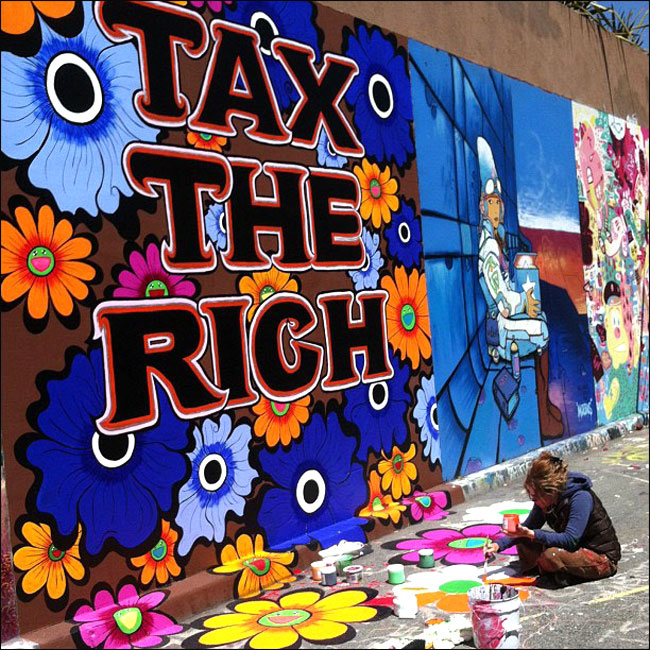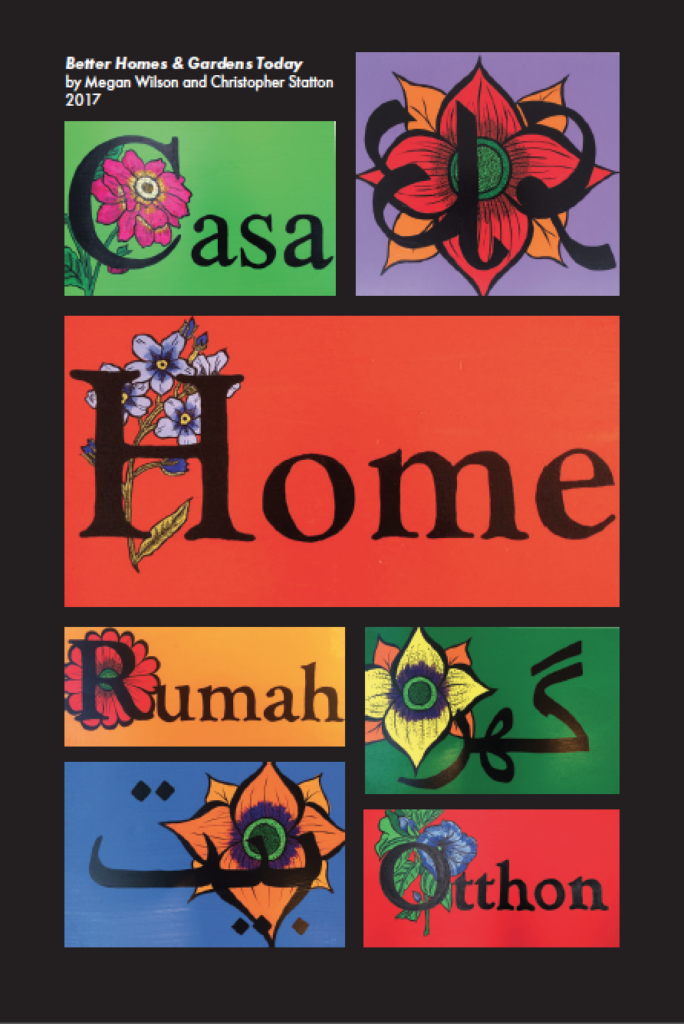I interviewed Megan Wilson and Christopher Statton, who are among a few of the major organizers of the Clarion Alley Mural Project (CAMP). CAMP, developed in 1992 by a group of local artists (Aaron Noble, Rigo 92, Sebastiana Pasztor, Michael O’Connor, Mary Gail Snyder, and Arcely Soriano), provides a voice for marginalized groups by creating public art revolving around compassion, respect, and social justice. Megan and Christopher have collaborated on various pieces for Clarion Alley and continue to create art together.

Can you describe your journey of becoming an artist?
Megan Wilson (MW): My journey of becoming an artist started as an undergrad at [the] University of Oregon in the early 90s. I originally was studying business, did that for three years, and then ended up feeling like that was not my calling. I’m really happy that I did it though, because I ended up applying it to the nonprofit world and helping organizations out. That’s the other thing I do—development, fundraising for organizations like the Gubbio project—but I did switch to art and ended up going on to get my Master of Fine Arts at the San Francisco Art Institute. After art school and while I was in art school, I kind of started to move away from the gallery as how I wanted to interface with the world. Not that I don’t do gallery shows, but I really do love working in the public realm much more. There’s something about that that’s much more satisfying and engaging. So I started doing more mural work, started doing more public projects, and now I’ve ended up working mostly in Asia [and] throughout the world, but a lot of projects within Indonesia—Indonesia is like my second home—the Philippines, India, Japan. I often will use flowers as a point of entry and engagement because flowers represent lifeforce. They represent giving, generosity. Most rituals include flowers as a form of beauty and life, so that is the point of entry for doing these harder messages such as “Tax The Rich,” “Stop The Corporatocracy,” or “Capitalism Is Over If You Want It.”
Christopher Statton (CS): When I was younger, I was always friends with people that were very artistically talented. My friends and I used to draw comic book covers of people that we knew and we’d make up stories and try to make each other laugh. We would do different types of sketching and stuff like that. I stopped doing art for many years, but was still always around that type of community. In 2007, I started a project with a friend of mine, Paul Gaffney, up in San Rafael. Paul runs the Marin Interfaith Street Chaplaincy, so we did a project called Sidewalk Sideshow, where people could play music, read poetry, be able to have that type of artistic expression. It was free for everybody. We cooked a huge meal and we invited people that were both housed, housing unstable, and unhoused, just to all sit together and share a meal and enjoy art. That was a really powerful thing to witness. Here’s where the art can have substance in this way of bringing people together and strengthening community. This kinda launched me in that direction. Then I [worked] at the Roxie Theatre, met Megan, and was invited to help out with the Clarion Alley Mural Project. Seeing these artists who are so talented and can create images that resonate with people and then choosing to make [art] around these political times that we live in, to be able to message around that and to be able to make people aware of what we’re really doing is such a powerful thing. That’s what kept me going.
MW: I’ve been involved with Clarion Alley Mural Project since 1998. It is a really special space because I believe it’s one of the only and the largest public space that provides a voice for communities that are marginalized and disenfranchised. We’ve really focused over the last 7-8 years now to become even more socially engaged and have more of a message for that because we’re living in times that really needs that message out there.

What kind of messages do you want your artwork to convey?
MW: Anti-capitalism, for sure—especially anti-free market capitalism—home and homelessness, but especially about generosity. Everybody deserves a home. Everybody deserves to be treated well and deserves love and kindness. At the very core, those are the messages that I’m working with. We’ve become such a corporate surveillance state, so also addressing that.
CS: Let’s just talk about the human toll of what we’re doing and human suffering. That touches upon everything because if your goal is to end human suffering, you will stop capitalism. You will stop all these institutions that are creating the suffering. It’s just a simple message that is really hard to argue. Who’s gonna be like “Oh no! I want more people to suffer”? It’s something that’s so universal and can lead to discussions like what Megan is talking about: Capitalism, the way it interacts with society, and the suffering that it creates.
MW: Approach it as a culture of sufficiency, rather than a culture of scarcity. We have enough. We have way more than enough. It just kills me that there are folks out there that are holding so tightly onto so much that exists on paper.
What is your experience as an artist, specifically in the Bay Area, especially with rising trends of gentrification, displacement, and homelessness?
MW: I’ve been evicted three different times—one ellis eviction. It’s a global issue. The inequity and the disparity between those who have a lot and those who have very little is growing so much. There’s this shift towards luxury. Everything that is being geared towards these people who have all this money. I did an exchange project in 2003 where I took artists to Indonesia to paint murals, and I brought artists from Indonesia here to paint murals. The Indonesian artists—all they knew of the US was what, of course, what they’d seen through television which is like, everybody has all this wealth—so they come here and they see a lot of people who are homeless, which was striking because in Indonesia, people were always taken care of. So they did do murals that addressed homelessness. Now, in Indonesia, they are starting to experience homelessness. It’s this western mindset that is just traveling around the world.
CS: The type of art that I’ve participated in and helped with has been public in terms of literally being on the street, painting everyday for many weeks. It’s amazing the difference between being someone who’s rushing from a location to a location all the time or being outside in one spot where people are rushing past you or people are interacting with you, how different of a space it feels with that experience. Painting on Clarion Alley, I got to know a lot of people. People would pass by everyday and say hi. I also got the chance to have conversations with people from all around the world because Clarion is a destination point now for tourism.
In what ways is your art related to addressing poverty or advocating for social justice?
MW: Definitely public messaging around social justice. Getting messages like that out, as well as publicly engaging with people and having these conversations and talking about it. Working in the public especially because you do have that opportunity to meet a lot of different people and to be able to have those conversations. I use the flowers a lot because it sort of takes the edge off of a very strong message such as “Tax The Rich.” Christopher and I are doing this project [called] “Better Homes and Gardens Today,” and it’s raising money for the Coalition on Homelessness, the Gubbio Project, At The Crossroads, so also using art as a way to call attention to these social needs, social justice, and raising money, and that it’s important to use our resources to help out one another.
CS: Being involved with the project with Clarion Alley or Better Homes and Gardens Today, where it’s not just directly my project. Helping to think about how to curate that space in terms of giving voice to people who know those issues way better than I do. I know a little about the issue, but I’m not actually out there every single day fighting that fight. I don’t know the intricacies of that issue, but I know that those are the people to talk to. I try to make it a point to have those dialogues cause each person coming up is someone new that has questions. I’ll learn something and hopefully they’ll learn something, and we can walk away more informed people.
MW: And Clarion Alley is an amazing platform that we have because it has grown to be so popular and so widely known throughout the world, which is one of the reasons why we have shifted to be more politicized to get these messages out on a much larger scale.
What inspires you the most to create art?
MW: Injustice. I think we’re both pretty similar on that—Injustice and inequity. ≠


